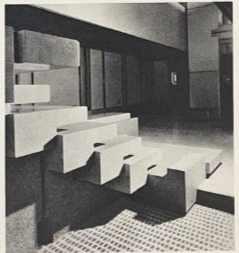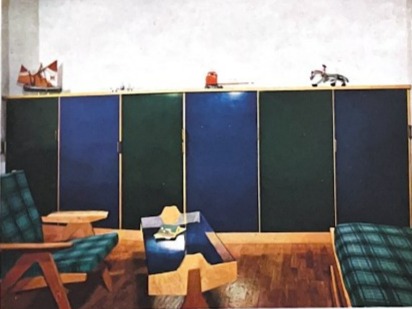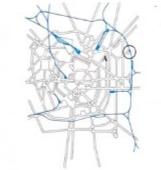The Modern Beauty of Italian Design
- Casa Collage
- Mar 20, 2022
- 5 min read
Updated: May 15, 2022
A design that has shown a historical concern for the everyday

Olivetti Showroom
The New Store of Olivetti in Venice
A long, dark alley was smartly transformed into an open jewel box, according to Igor Fracalossi (2011). Through the addition od windows and attention to interior transparencies, Scarpa blended the exterior and interior and was able to open the Olivetti showroom into a light, comfortable place for visitors.

Side Facade of the shop in Istrian stone

Carlo Scarpa Arch.
1957-8

Orch_chemollo, Side Facade [Photography], 2011.

The light is controlled through these additional windows to the exterior, wooden grids on the second floor to control the intake of lighting, as well as though Scarpa's choice of materials for the interior.

Located on the northern edge of Piazza San Marco in Venice, Italy, the Olivetti showroom by Carlo Scarpa is a beautifull space used for decades by Olivetti before changing owners. In April 2011 re-emerged once again as the display space for Olivetti products. However, this time was Scarpa's design what is truly on display.
Interior views seen from the stained glass windows on Corte del Cavalletto.
Domus 1960

An advertisement designed by Paul Rand. 1953, for the Olivetti Lettera 22

The Olivetti company was a typewriter manufacter experimenting with producing early computers and calculator by the 1950s. The appreciation of quality and design was represented in their products, as well as in its spatial design.
An Olivetti Lettera 32 portable typewriter, 1963 designed by Marcello Nizolli

MARCELLO NIZZOLI
(1887-1969).
A key pigure in mid-century Italian product design,
noted for his work with Olivetti.
2+7 telephone amde using cellulose acetate, rubber, metal and paper,
by Safnat, 1958
Located on the northern edge of Piazza San Marco in Venice, Italy, the Olivetti showroom by Carlo Scarpa is a beautifull space used for decades by Olivetti before changing owners. In April 2011 re-emerged once again as the display space for Olivetti products. However, this time was Scarpa's design what is truly on display.
Interior views seen from the stained glass windows on Corte del Cavalletto.
Domus 1960

Salvaing, Mathieu 2017 [Photograph] dezeen.com
An exhibition of Milanese designer and Memphis group founder Ettore Sottsass' little-known ceramics displayed at Olivetti's Venice showroom. The show sets up a dialogue between the work of the two designers.
Seventy pieces -created by Sottsass between 1957 and 1969 -are positiones throughout the two-storey space.
Interior in Milan

Ettore Sottsass known as a radical designer who led a group of designers in questioning their roles in society in economics, in fueling a consumer society in the post-war period.
Designers are part of the problem in terms of consumerism using materials, fueling, inequality, etc. But also design has been the backbone of capitalism, consumption and industrialisation, and in that sense we (designers) have an original sin.
Sottsass, recognising this sin, created a kind of informal conversation group without the designers to think about how designers might become part of the solution rather than part of the problem.
Dining Room screen. Domus 1960
However in 1987 he still continued designing and producing objects. his justification? the idea of permanence and perfection.

In the living room, a designed glass wall isolates the dining area; the cushions are Yugoslavs; the sleep ceramics by Sottsass, made - like the others that appear here - by Bitossi di Montelupo Fiorentino for Il Sestante di Milano. Domus 1960

In the dining area, the wall of wood and wall bears an old family clock, two popular Chinese textiles, a lead brass-relief by Arnaldo Pomodoro. The opening between this area and the entrance is crossed by shelves Domus 1960

Sottsass , who died in 2007, has been an inspiration for many contemporary designs, including the Sass pedestals by MPGMB and a series of limited-edition vases by Studiopepe. Kartell also recently put a number of the designer's pieces into production for the first time.
Designed for Brooklyn brand Souda, the wood and marble Sass stands are inspired by Sotsass.
Dining area. Domus 1960

MPGMB pedestals inspired by the work of Postmodern master Ettore Sottsass.

New York exhibition of pre-Memphis work of Ettore Sottsass, 2015
Ettore Sottsass is best-known for the colourful and radical Memphis design movement of the 1980s. His works include furniture, lighting, objects, ceramics ans paintings. While Memphis design movement of 1981 to 1987 used bright colours and manmade materails like plastics and laminates in pieces, such as for the Carlton bookcase, the early works, such as the project of the picture, are made of natural materials like rosewood, walnut, bronze, and terracotta.
Parphrasing Marc Benda owner of Friedman Benda, ̋he was prolific in his practice, usually ahead of his time ans constantly reinterpreted design based on his life experiences and world travel.̋ About that Sottsass told Domus magazine in 1963: I have tried ... to collect the shapes, colours ans symbols yhat could represent the change in the images of this century from an intellectual organisation to a reality that must be lived, to a kind of pure and vital energy.

Living room. Domus, 1960.
One chair, one armchair

Gio Ponti had made a call of the importance of the ergonomics and its realatioship with anthropometrics when designing. Designers should consider usability so their products are inclusive, easy to use and do not cause discomfort, pain or even injury.
̋The inclination of the backrest of chairs and armchairs has always been corrected with a cushion that supported the kidneys. Why not correct the shape of the back? This was done. To the chairs thus conceived, we add this recent model: naturally these chairs are more suitable where the upright position is comfortable (for writing, for eating), and have proved to be very comfortable.̋ Wrote Ponti in the editoriale of Domus Magazine 1949.

Vinicio Vianello series lamps

Vinicio Vianello is one of the most significant personalities of the Murano scene of the period after the second world war. Born in Venice in 1924, he attended art studies at the local Fine Arts Academy.
He became interested in glass as a means of artistic expression, and after having worked briefly for some Murano furnances, he exhibited his first creation at the 1950 Venice Biennale.

Nelson modular lamp. Domus, 1960.
Room for two children
Domus, 1949
Luisa Castiglioni and Ritta Mori Bravi, arch.
This room is intended for two children, and serves them as a bedroom and living room. One wall of the room is occupied by the long wardrobe that contains all the children’s clothes and some cabinets are dispossed under the desk surface to have more storage. The doors are painted in colour and a part of the interior is also reserved for bulky toys.
Luisa Castiglioni, graduated in July 1946 at the high school of architecture at the Politectico of Milan, she took part of different conmpetitions. In the following years Castiglioni followed some project of private residence and shops. At the same time she always worked in the interiors' planning, but also a series of office's furniture.
Since the 70's architect Castiglioni continues to dedicate to the planning of private buldings, hotels and art gallery.

Broccole a Murano, Luisa Castiglioni 2011.
Lambrate New Station, Milan

̋If someone ask me what architecture is , I reply: Give me a theme and a place , and I will give you a project.̋ Ignazio Gardella.
Domus 1986
Ignazio gardella was an Italian architect, engineer, academic, and designer born in Milan in a genovese family of architects. Gardella is considered a prominent member of the so-called third generation of the Italian Modern Movement, as well as one of the greatest exponents of Italian Rationalism. Throughout his career he was also a successful furniture and lighting designer and co-founder of the design and furniture manufacturing company Azucena.

Azucena's Lamp

Ignazio Gardella, 1985

















Comments